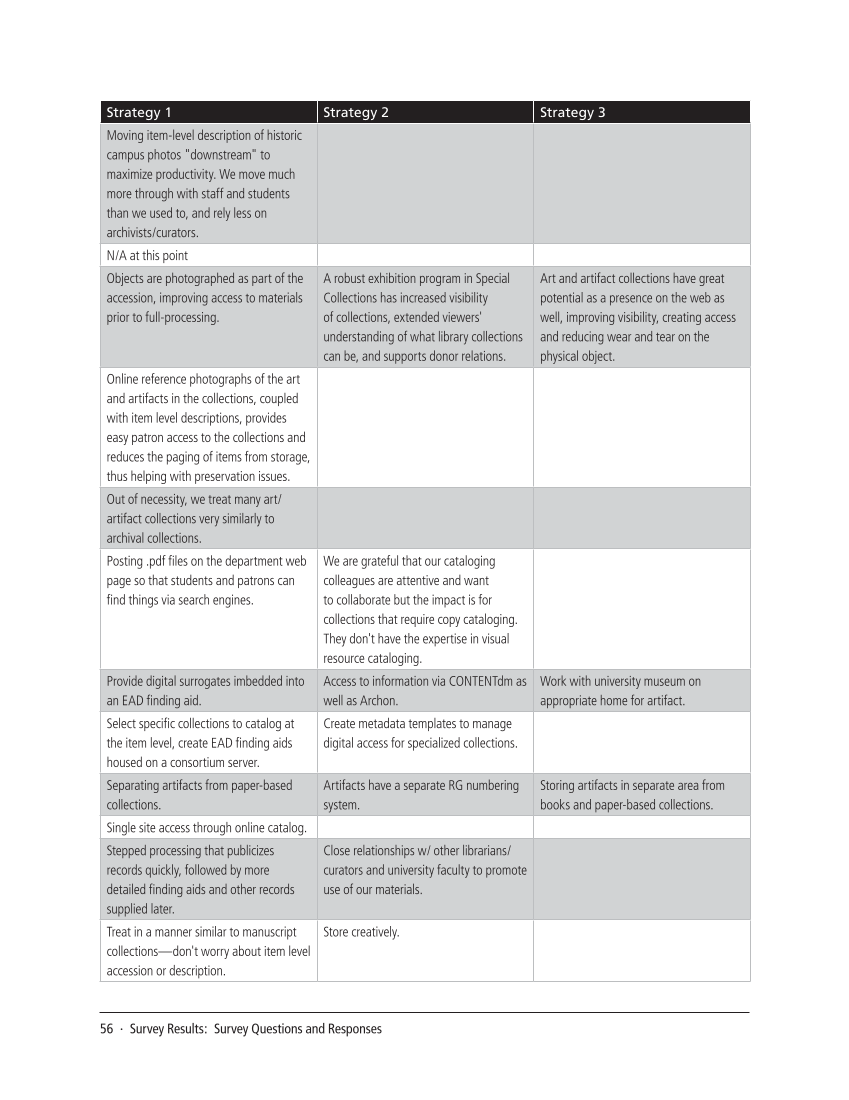56 · Survey Results: Survey Questions and Responses
Strategy 1 Strategy 2 Strategy 3
Moving item-level description of historic
campus photos "downstream" to
maximize productivity. We move much
more through with staff and students
than we used to, and rely less on
archivists/curators.
N/A at this point
Objects are photographed as part of the
accession, improving access to materials
prior to full-processing.
A robust exhibition program in Special
Collections has increased visibility
of collections, extended viewers'
understanding of what library collections
can be, and supports donor relations.
Art and artifact collections have great
potential as a presence on the web as
well, improving visibility, creating access
and reducing wear and tear on the
physical object.
Online reference photographs of the art
and artifacts in the collections, coupled
with item level descriptions, provides
easy patron access to the collections and
reduces the paging of items from storage,
thus helping with preservation issues.
Out of necessity, we treat many art/
artifact collections very similarly to
archival collections.
Posting .pdf files on the department web
page so that students and patrons can
find things via search engines.
We are grateful that our cataloging
colleagues are attentive and want
to collaborate but the impact is for
collections that require copy cataloging.
They don't have the expertise in visual
resource cataloging.
Provide digital surrogates imbedded into
an EAD finding aid.
Access to information via CONTENTdm as
well as Archon.
Work with university museum on
appropriate home for artifact.
Select specific collections to catalog at
the item level, create EAD finding aids
housed on a consortium server.
Create metadata templates to manage
digital access for specialized collections.
Separating artifacts from paper-based
collections.
Artifacts have a separate RG numbering
system.
Storing artifacts in separate area from
books and paper-based collections.
Single site access through online catalog.
Stepped processing that publicizes
records quickly, followed by more
detailed finding aids and other records
supplied later.
Close relationships w/ other librarians/
curators and university faculty to promote
use of our materials.
Treat in a manner similar to manuscript
collections—don't worry about item level
accession or description.
Store creatively.
Strategy 1 Strategy 2 Strategy 3
Moving item-level description of historic
campus photos "downstream" to
maximize productivity. We move much
more through with staff and students
than we used to, and rely less on
archivists/curators.
N/A at this point
Objects are photographed as part of the
accession, improving access to materials
prior to full-processing.
A robust exhibition program in Special
Collections has increased visibility
of collections, extended viewers'
understanding of what library collections
can be, and supports donor relations.
Art and artifact collections have great
potential as a presence on the web as
well, improving visibility, creating access
and reducing wear and tear on the
physical object.
Online reference photographs of the art
and artifacts in the collections, coupled
with item level descriptions, provides
easy patron access to the collections and
reduces the paging of items from storage,
thus helping with preservation issues.
Out of necessity, we treat many art/
artifact collections very similarly to
archival collections.
Posting .pdf files on the department web
page so that students and patrons can
find things via search engines.
We are grateful that our cataloging
colleagues are attentive and want
to collaborate but the impact is for
collections that require copy cataloging.
They don't have the expertise in visual
resource cataloging.
Provide digital surrogates imbedded into
an EAD finding aid.
Access to information via CONTENTdm as
well as Archon.
Work with university museum on
appropriate home for artifact.
Select specific collections to catalog at
the item level, create EAD finding aids
housed on a consortium server.
Create metadata templates to manage
digital access for specialized collections.
Separating artifacts from paper-based
collections.
Artifacts have a separate RG numbering
system.
Storing artifacts in separate area from
books and paper-based collections.
Single site access through online catalog.
Stepped processing that publicizes
records quickly, followed by more
detailed finding aids and other records
supplied later.
Close relationships w/ other librarians/
curators and university faculty to promote
use of our materials.
Treat in a manner similar to manuscript
collections—don't worry about item level
accession or description.
Store creatively.


















































































































































































